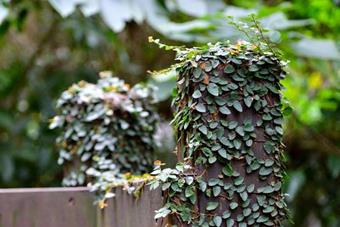薜荔 Climbing Fig or Creeping Fig (Bili)

Climbing Figs (Bili) can be found everywhere in Taiwan, from the plains to low-elevation mountain regions, and especially in central and northern Taiwan. They generally use their aerial roots to firmly station themselves, and climb stone walls, fences, or tree trunks to receive more sunlight. People generally cannot tell the difference between Climbing Figs and Ficus pumila var. awkeotsang (Aiyu). The leaves of Aiyu are bigger and pointier, those of Climbing Figs smaller and blunt.Aiyu fruit are bigger and have a long, oval shape with white spots scattered on the surface, whereas those of Climbing Figs are smaller and reverse-conoid-shaped, with white spots appearing only on the tips. The mature seeds of Climbing Figs contain water-soluble pectin, readily producing a semiopaque or light-yellow gel used to make jelly, just like Aiyu seeds.
